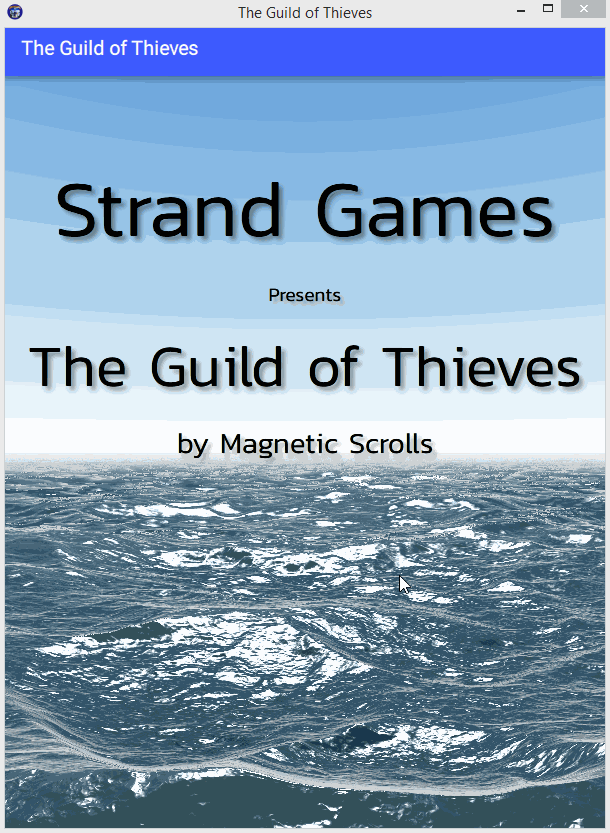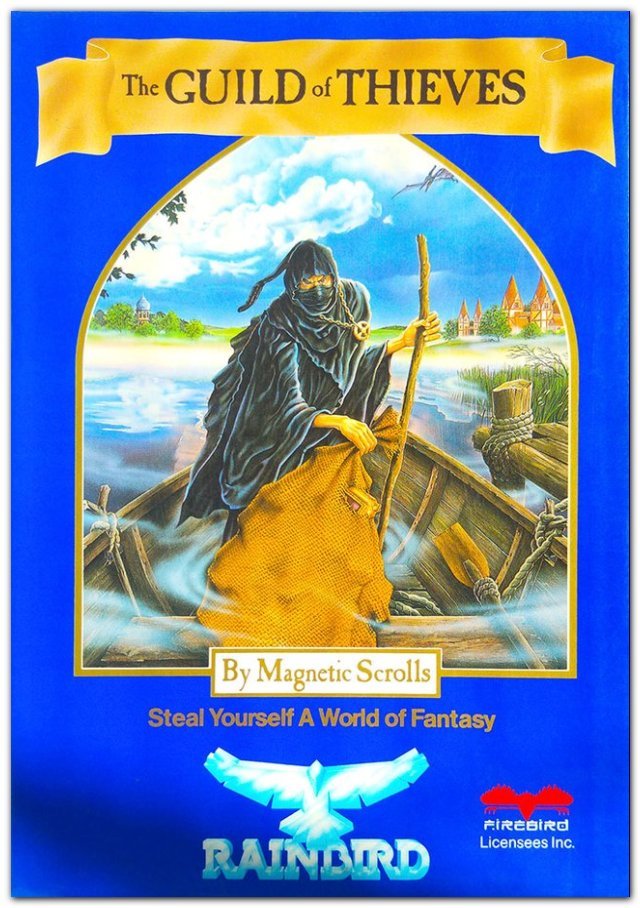The Guild of Thieves (1987) was the second game published by Magnetic Scrolls. It was very popular and did a lot of things right.
The Guild has a simple overall game mechanic and was what Scrolls called a "collect the treasures game". Although this phrase somewhat oversimplifies the story, there are some important aspects to this approach that significantly contribute to overall popularity;
-
It's easy to understand
This should not be underestimated. Understanding what the game is about and, broadly, what you have to do is important for the player (and marketing).
-
You know where you stand
Although games usually have a scoring system, and often tell you the maximum score, there's nothing quite as good as knowing you've done 4 things out of 10. You know, broadly speaking, you're about 40% though the game - and that's always nice to know.
-
You can solve puzzles in parallel
Depending, of course, on the interdependency of the puzzles, it's nice to be able to try a bit of one, then if you get stuck, try a bit of another. When you've got to collect X "treasures", so long as there's more than one puzzle open at any time, it gives the player the opportunity to switch if they get stuck - and this is always nice.
Several Magnetic Scrolls fiction works experimented with, at the time, new and untested game mechanics. They didn't always work as well as expected, but The Guild wasn't an experiment in gameplay. It was overall a simple concept that left creativity to the details. It worked well, and serves as a successful exposition of keeping things simple and not overcomplicated.
Remastering under Brahman
Strand Games will be releasing the "restored" version of The Guild for the Brahman platform. Brahman is a technology that separates the front-end GUI experience from the back-end game engine. Brahman supports multiple back end systems, but for The Guild, it will use the magnetic back-end.
The Brahman system has been developed specifically for the modern touch-based UI of mobile phones and pads, but also runs on desktop systems including; Windows, Mac and Linux. Now that many laptops also have touch screens, it's nice to make use of that too.

After the successful release of The Pawn under Brahman, the game can now customise the front-end user experience. For example, theming has been added and each new game released will have its own default theme (you'll be able to customise the theme too).
We're going to have a base theme colour and effect for each game. The Pawn was red with hellfire, The Guild will (probably) be Scrolls Box blue with water (Fish will have underwater bubbles).
Here's a sneak preview of the forthcoming Guild of Thieves Restored. You can see that the inventory roster, clickable text, map and compass are already working. This comes directly from the game data itself via the magnetic back-end.
It looks playable, and it is! But there's a still a lot to do in order to enhance the game play experience for the 21st century.

The rest of this articles covers the more technical aspects of remastering The Guild from its original game sources.
Building from the original source code
For the first time, after the recovery of the original source files with (a lot) of help from DEC expert Rob Jarratt, we have the opportunity to restore, remaster and re-release The Guild of Thieves from scratch (Note: The Pawn was remastered from it's original binaries and not recompiled - although we may now have the technology to do that).
Here's how we go about the build process;
The aim of the build process is to produce two files; the program and the text. So for The Guild, this will be guild.prog and guild.text. In the original mastering, there was a further stage to compress the text and combine the result with the program to produce a single final installable.
However, for the purposes of simulation or running under Brahman, we just need the text and program as separate files.
Generating these consists of three stages:
Fred23jrcrunching the fred23 world-model data into output source files and text.- Assembling and linking the result together with the system source into
guild.prog. - combining
fred23jrtext output with scenario text and system text into the finalguild.text.
For the input side you need:
- The Magnetic Scrolls system source files.
- The
fred23jrinput source files (in fact for The Guild, it's justguild.f23). - The scenario & system text files.
- The Guild scenario source files (logic for the story).
- The build files (makefile & lfile to drive the build process).
- The build tools (as68, lnk, make, fred23jr).
To run the result, you can either run the prog and text output directly in the Magnetic Scrolls simulator (used originally to debug the game), or in the Brahman magnetic back-end.
Brahman Magnetic Engine
The Brahman magnetic back-end was originally designed to run the original game images (eg guild.mag), but it has been extended to run prog format binaries. The prog format is the output of the build process (eg guild.prog) and is a simple format that contains the game binary, data and symbol table.
Importantly, note that the prog file does not contain the game text. The text output of the build process has to be supplied to magnetic as well. Magnetic will automatically look for a .text game file for the messages when running a prog binary.
This keeps things simple because the message text file supplied to magnetic can be edited post-build to add markup to the messages. Markdown style formatting in the text is recognised by the Brahman front end GUI and displayed appropriately (it converts to HTML).
Something really quite cool has been gained by running prog files in magnetic. Aside from the the fact that we're now rebuilding and running the code ourselves (rather than original release binaries), magnetic has access to all game variables and states via the symbol table.
The symbol table is basically a description of where all the game variables live in the memory image. So, for example, if we want to access the game score to put on the GUI, we can lookup the symbol SCORE then access that location in the game memory image to get (or set!) the current game value. Pretty neat!
We'll be using this feature a lot in the remastering of The Guild to allow the UI to be aware of the state of story puzzles and other internal game state (all without actually changing the game code). The UI can then provide hints or help for the player if requested.
Remastering and Original Source Files
This sneak peek at The Guild work in progress, shows that bringing these games back for the 21st century is not only possible, but it's happening (at last). We plan to make all source code available and especially copies of the original game sources (in fact, I've been re-organising the codebase in readiness for this).
Any and all new content or changes to the games will be kept separate so that historians (and those curious) can see which bits are original and which are new. For example, some of the original puzzles are too unforgiving for the modern player (the game would kill you at the drop of a hat, almost literally!). Alternate versions will be added separately and both versions will be included in the remastered product. As we did for the remastering of The Pawn, you can choose between classic mode and modern mode in the settings.
The Guild of Thieves Restored will be available for Windows, Mac, Linux and mobiles Android and iOS.
We plan to follow the "pound a punt" model we adopted for The Pawn where we net about 1 GBP, after fees and sales tax. Monies collected are going towards paying for web hosting, the domain as well as Apple developer fees and other direct costs.
Since we debuted on itch.io, I have been amazed at the words of support and feedback from people. All suggestions, comments and ideas have been noted. If you've got a request or a feature you'd like, do let us know!
Thank you very much to all those people who've purchased the product and special thanks to those who have tipped us over the base Itch price. I'm impressed! Most definitely, you are helping this initiative become a reality.
-- The Strand Team.
PS. Don't forget to checkout the forum.
